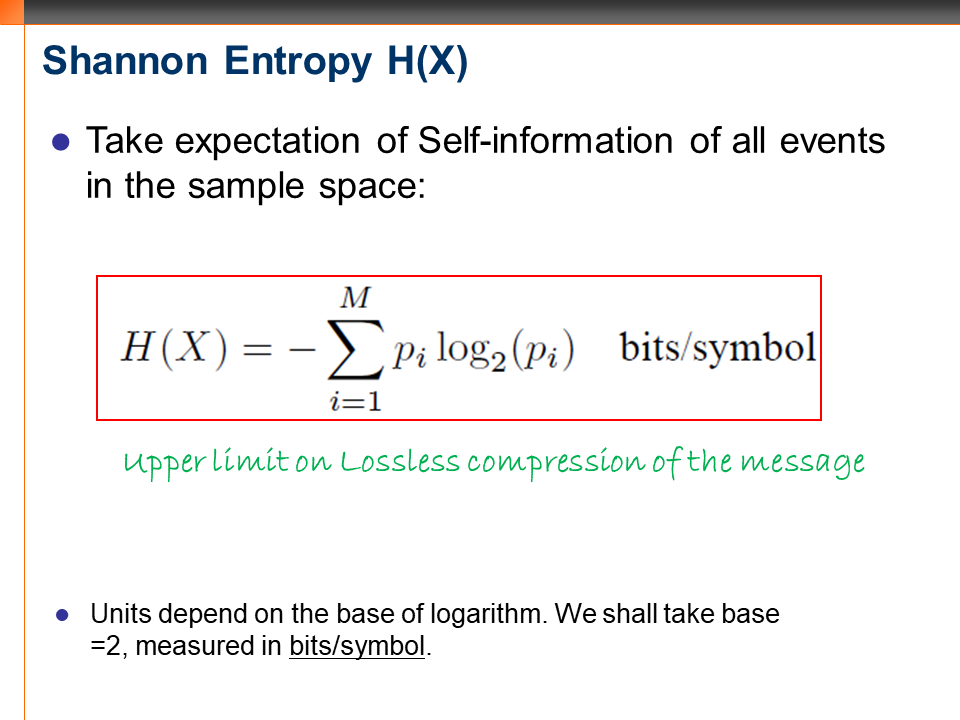03 Feb 2020 - Rahul Venugopal
Discrete random variable
X is a function from the outcomes to the real line
For example: RV is a function which is mapping sample space’s individual outcomes to numbers
We have probabilities associated with these random variables
Sum of all probabilities equals one. $\sum_{i=1}^{n}p_i=1$ and Sample space of $X$ is $S$
Self information, $i(p(x_j))=-log_2$ $p(x_j)$ bits
Weighted average of this self information gives us entropy, $H(X)$. Weights are the probabilities $p(x_i)$
$H(X)=E(-log$ $p(x))$
Definition of expectation of X: $E(X)=\sum_{i=1}^{n}p(x_i)$
$x_i = x1,x2,……x_n$ with probabilities $p1,p2,…..p_n$
$E(X)$ will give us average loss/gain if we take the example of gambling
History and Motivation
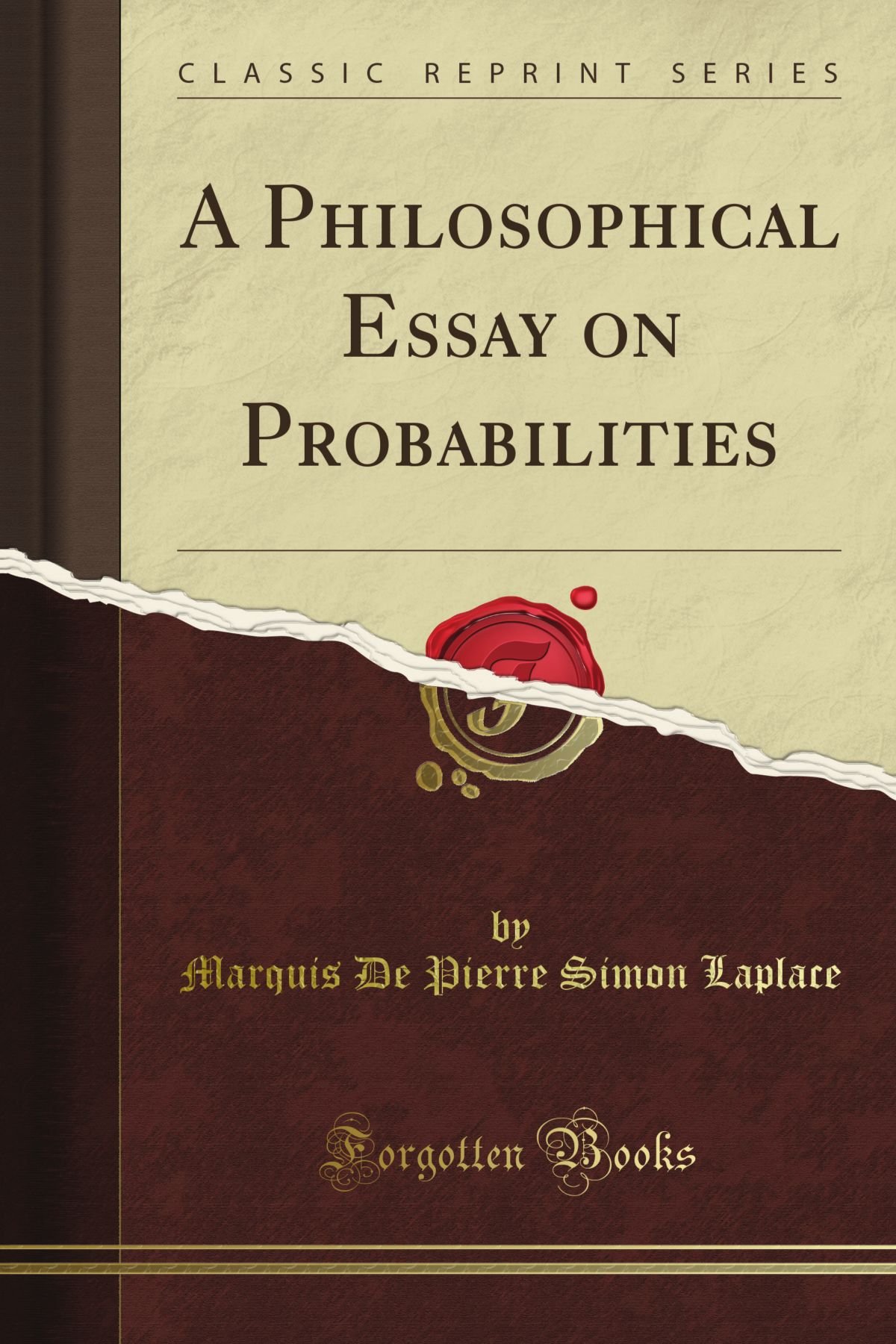
- History of probability theory in embedded in the context of gambling
- Motivation for probability theory came from gambling, people wanted to bet and wanted to come up with a plan to win
- Once we have random variables, we can compute expected values, mean, variance, distribution, equilibrium etc.
- E(x) is the average value of many gambling trials
- Gambling and world wars lead to lot many developments in mathematics (Ex: Breaking enigma, Computing systems)
- Laws of probability, conditional probability, Bayes theorem were developed around those years
Axioms of entropy
Axiom 1
$H(p_1,p_2,p_3,…….p_n)\geqslant 0 $
The entropy of a random variable with n discrete outcomes of probabilities $p_1,p_2,….p_n$ will always be greater than or equal to zero
Axiom 2
$H(X)$ will be continuous in $p(S)$
Even if we perturb the probability values, the entropy cannot change drastically
Axiom 3
Let us take $n$ outcomes which are equally likely (coin toss or rolling a dice) and when $n$ increases, then the function $H(X)$ also increases monotonically with $n$
As per this axiom, the entropy of an unbiased coin is less than the entropy of an unbiased die
The uncertainty in choosing an outcome of die is more since there are larger number of states and hence more information/entropy
Axiom 4
There are two random variables $X$ and $Y$ and if they are independent, the joint entropy, $H(X,Y)$ is the sum of their individual entropies $H(X)$ and $H(Y)$. The entropy gets added up.
Say, $X$ is a random variable (tossing a coin) and $Y$ is the random variable (rolling a dice), the uncertainty in rolling the dice remain intact even if know uncertainty in tossing the coin. Knowing head or tails of the coin won’t help in reducing the uncertainty in the numbers which comes out from rolling dice
Mutual information, $I(X,Y)$ comes into picture when $X$ and $Y$ are not independent
Axiom 5 - Grouping axiom
We begin with a set of random variable, $x_i$ with probabilities $p_1,p_2,p_3,…..p_n$
The set is now broken into two sets. Set A and Set B. A and B are disjoint sets with probabilities
$p(A)={p_1,p_2,p_3,…….p_r}$ and $p(B)=p_{r+1},p_{r+2},+…….p_n$.
$p(A)+p(B)=1$
The grouping axiom says that, the entropy of the entire set can be written as:
\[H(p(A),p(B))+p(A)*H(\frac{p_1}{p(A)},\frac{p_2}{p(A)},.....\frac{p_r}{p(A)}) +p(B)*H(\frac{p_{r+1}}{p(B)},\frac{p_{r+2}}{p(B)},.....\frac{p_n}{p(B)}\]To find the uncertainty of an outcome, first we are going to list the outcome either in A or in B
Once we list the outcome in say set A, we need to think only about of uncertainty within A (out of r outcomes). This approach is like divide and conquer
The new probabilities are more like conditional probabilities. The breaking can also be into sets of three or four. We have to compute, the conditional probabilities accordingly
We are trying to index every outcome. First level of indexing is whether outcome belongs to set A or B. Second level of indexing would be within A or within B. Multiple level or nested indexing are also possible and axiom would still hold
Summary
What Shannon showed was
\[H(p_1,p2,p_3,...p_n)=-k\sum_{i-1}^{n}p_i*\log p_i \text{ bits}\]Only this equation satisfies all the five conditions in above axioms of entropy
$k$ varies when the base of logarithm changes
Conditional entropy
Let us say we have $x_i$ and $y_j$ as two outcomes
$I(x_i/y_j)$ is called conditional self information of $x_i/y_j$ which is expressed as $-log_2 $ $p(xi/yj)$
We have two random variables $x$ and $y$ where $x_i = x_1,x_2,…x_n$ and $y_j = y_1,y_2,…y_m$
Conditional entropy, $H(X|Y)$ = $\sum_{i=1}^{n}\sum_{j=1}^{m}p(x_i,y_j)*-log p(x_i/y_j)$ bits
$p(x_i,y_j)$ is the joint probability density function or joint probability mass function
The weights are joint probabilities, we have to know the probability of how they occur together
We need the joint PDF to calculate the expected value
When $x_i $and $y_j$ are independent random variables it means that all pairs of $x_i$ and $y_j$ are independent
| $H(X | Y) = \sum_{i=1}^{n}\sum_{j=1}^{m} p(x_i)p(y_j)*-log(p(x_i))$ |
$=\sum_{j=1}^{m} p(y_j)\sum_{i=1}^{n}p(x_i)*-log(p(x_i))$
$=1*H(X)$ bitsKnowing $Y$ doesn’t help to improve uncertainty in $X$, $H(X)$
$H(X|Y)$ means what is the uncertainty in X after knowing $Y$. The uncertainty in $X$ remains the same even before knowing $Y$ and after knowing $Y$ when $X$ and $Y$ are independent
If $x_i$ and $y_j$ are completely dependent, $p(x_i/y_j)=1$. Then,
$H(x_i|y_j)$ = 0 bits
When $x=f(y)$ and $f$ is deterministic OR a table lookup. Given that $y$ has occurred, we can find everything about $x$. There is no uncertainty in $x$ once $y$ is known
This can happen when $X$ and $Y$ are mutually exclusive also
But, if $x$ is a stochastic function $f(y)+\epsilon$, then there will be some uncertainty around $x$ even after knowing $y$
$H(Y|X)$ not equal to $H(Y|X)$ These are not symmetric/commutative
$H(X)>= H(X|Y)$ This is an important relation
Knowing $Y$, $H(X|Y)$ can always be equal or less than $H(X)$
Mutual Information - I(X,Y)
$I(X,Y)$ is defined as mutual information
$I(X,Y) = I(Y,X)$ Mutual information is symmetric. Sometimes one of this will be easy to compute.
Mutual information tells us what information is common between X and Y random variables
Consider $x$ as input to a channel and $y$ as output (The channel can be a neuron/synapse or a cable), then the mutual information is the information which is transmitted through the channel
IF $x_i$ and $y_j$ are independent then $p(xi/yj)=p(xi)*p(yj)$. Nothing is common between these two outcomes
$I(x,y)= 0$ bits when they are independent
If $x_i = f(y_j)$, then $I(x_i,y_j) = log(1/p(x_i))$ = $-log$ $p(x_i)$
This is self information of $x_i$
IF the channel is deterministic, whatever uncertainty in X is transmitted via the channel just like that
Mutual information can be visualised as the quantity of information that is transferred reliably across the channel. The uncertainty comes through just like that, that is the best we can do in terms of improving the channel
If the channel is carrying zero information, it is a terrible channel
This book provides a self-contained review of relevant concepts in information theory and statistical decision theory. This book discuss the topic of stimulus response curves. There is a particular stimulus which gives maximum response value. How much information of the stimulus is conveyed by the response is represented as a stimulus-response curve.
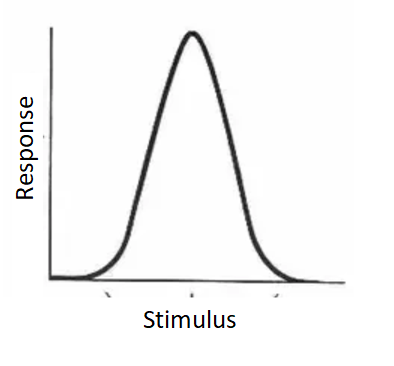
Proof for symmetry property of mutual information
$I(X,Y)=\sum_{i=1}^{n}\sum_{j=1}^{m} p(x_i,y_j)*log(\frac{p(x_i/y_j)}{p(x_i)})$ bits
\(=\sum_{i=1}^{n} \sum_{j=1}^{m} p(x_i,y_j)* \log(p(x_i/y_j) - \sum_{i=1}^{n}\sum_{j=1}^{m}p(x_i,y_j)* \log(p(x_i))\)
\(=\sum_{i=1}^{n}\sum_{j=1}^{m}p(x_i,y_j)* \log(p(x_i/y_j) - \sum_{i=1}^{n}\log(p(x_i)) \sum_{j=1}^{m}p(x_i,y_j)\)
\(= -H(X\|Y)+H(X)\)
$I(X,Y)=H(X)-H(X|Y)$
Mutual Information,$I(X,Y)$ = Entropy in X, $H(X)$ minus uncertainty in $H(X)$ after knowing $Y$
$\sum_{j=1}^{m}p(x_i,y_j)=\sum_{j=1}^{m}p(y_j/x_i)*p(x_i)$
$=p(x_i)\sum_{j=1}^{m}p(y_j/x_i)$
$=p(x_i)*1$
Similarly, $I(Y,X)=H(Y)-H(Y|X)$
This can be proved by multiplying and dividing by $p(y_j)$
\[I(X,Y)=\sum_{i=1}^{n}\sum_{j=1}^{m}p(y_j,x_i)*\log\big[\frac{p(y_j/x_i)}{p(y_j)}*\frac{p(y_j)}{p(y_j)}\big]\] $=I(Y,X)$
$=I(Y,X)=H(Y)-H(Y|X)$
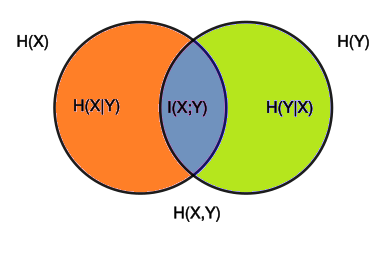
How to transmit information efficiently, securely across a noisy channel
Efficiency, security and reliability of the channel are three key things when we transmit information from point A to point B. These two points can be space,time or space-time
The receiver has to revert/inverse these steps to recover back information
Compress –> Lock –> Error correcting coding –> Error correction decoding –> Unlock –> Decompress These are the steps followed from point A to point B. The three major steps need not be there always in an information transfer. Example: Storing passwords in computer. We might not need encryption or compression. We can have all combinations of these three fundamental chains of communication- Compression, Encryption and Error correction
Summary
Entropy
Boltzmann’s tombstone has the second law of thermodynamics carved in
Shannon’s 1948 paper covered source coding and error correction. 1949’s paper covered encryption

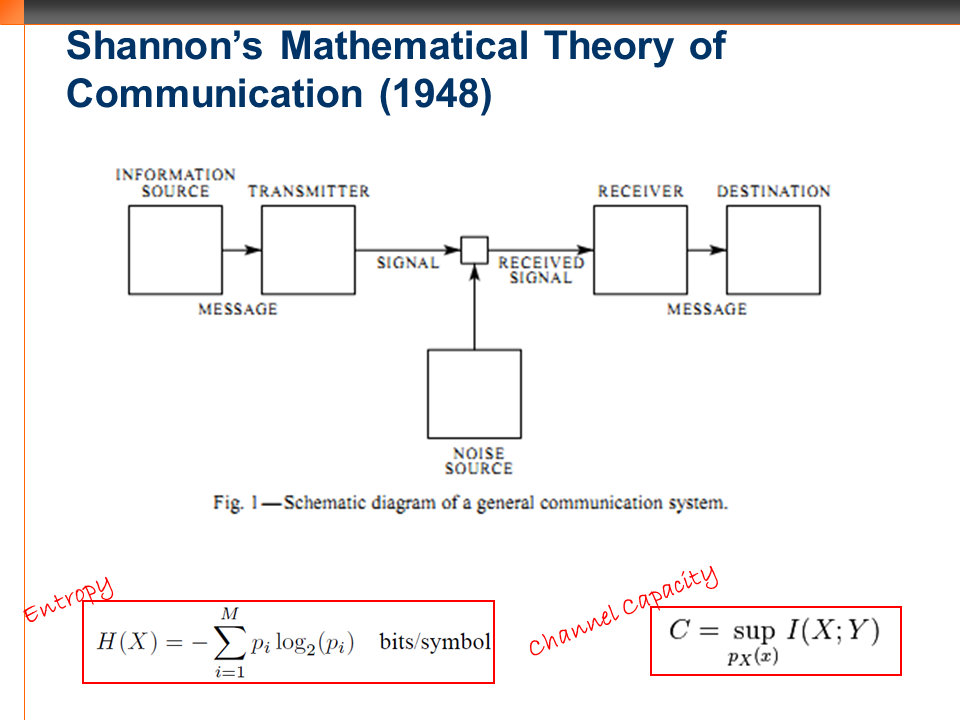
Entropy is that part of energy which cannot be converted to work. Shannon is the father of cybernetics. He designed a mechanical mouse which could adaptive learn maze travel. He even came up with a juggling theorem
The word bit was attributed to John Tuckey of Bell labs. Even Nyquist theorem is actually Shannon-Nyquist theorem







